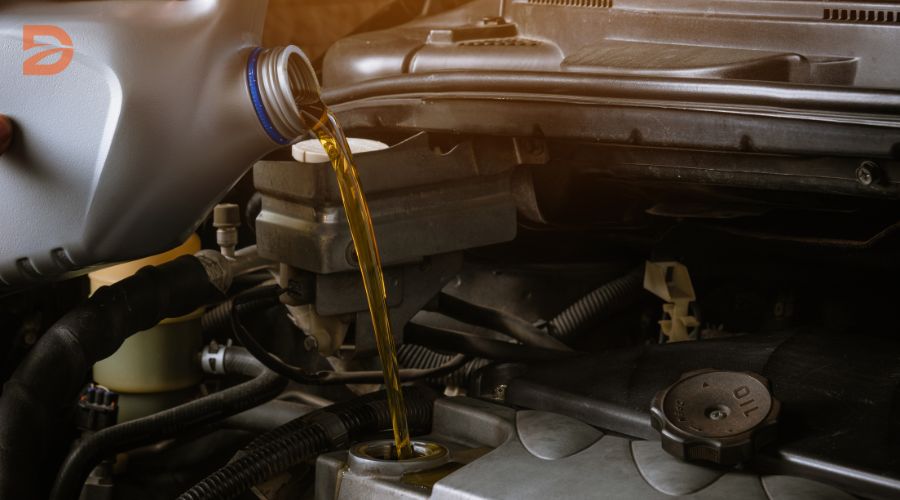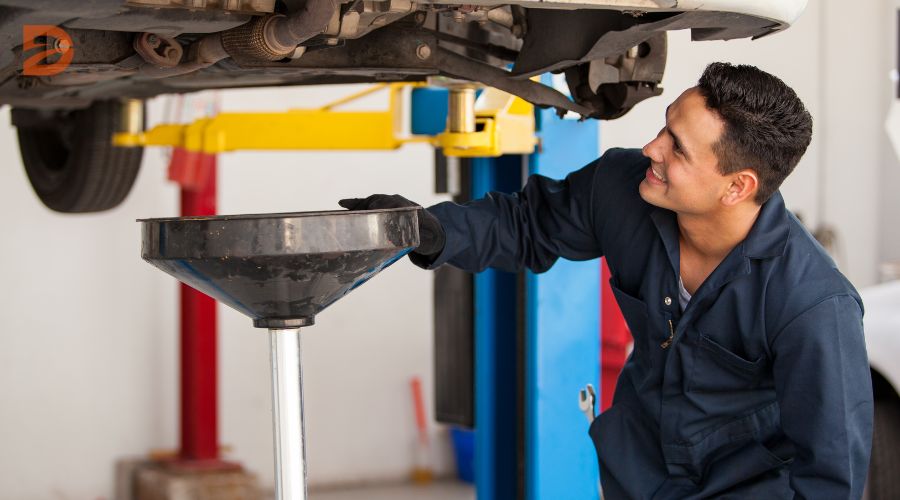Are you tired of the hassle and expense of taking your car to the mechanic for a routine oil change? DIY oil change kits may be the solution you’ve been searching for. By taking on this simple task yourself, you can not only save money but also gain a deeper understanding of your vehicle’s maintenance needs.
Changing your car’s oil is a fundamental part of keeping it running smoothly and efficiently. With the right tools and high-quality synthetic oil, you can ensure your vehicle’s longevity and optimal performance. DIY oil change kits provide everything you need, from the necessary fluids to the essential tools, making the process straightforward and convenient.
Key Takeaways
- DIY oil change kits offer a cost-effective and convenient way to maintain your vehicle’s health.
- Performing your oil changes can help you become more self-reliant and knowledgeable about your car’s maintenance needs.
- Using high-quality synthetic oil, such as Pennzoil Platinum® High Mileage Full Synthetic, can extend the life of your engine.
- DIY oil change kits make the process easy, with all the necessary supplies and tools included.
- Changing your oil can save you time and money compared to taking your car to a mechanic.
Benefits of Changing Your Oil
Performing your oil change can provide several notable advantages. Firstly, it can save you a significant amount of money compared to taking your car to a professional shop. By avoiding labor costs and mark-ups on parts, you can keep more of your hard-earned cash in your pocket. Additionally, you’ll have the flexibility to fit the oil change into your schedule at your convenience, rather than waiting for an appointment at a service center.
Save Time and Money
DIY oil changes typically take 20-30 minutes, which is considerably less time than going to a service center. This time savings allows you to be more productive and efficient with your day. Furthermore, the cost savings can be substantial, as the essential tools for a DIY oil change, such as an oil drain pan, oil filter wrench, and replacement drain plug washer, are relatively inexpensive investments.
Become More Self-Reliant
By taking on the task of changing your own oil, you’ll become more self-reliant and gain a better understanding of your vehicle’s maintenance needs. This knowledge can empower you to tackle other DIY car maintenance tasks in the future, further enhancing your self-reliance and saving you money in the long run.
| Benefit | DIY Oil Change | Professional Oil Change |
|---|---|---|
| Time Savings | 20-30 minutes | 15-30 minutes |
| Cost Savings | Reduces labor costs and part markups | Includes labor and parts markup |
| Cleanliness | Potential for oil/dirt stains | Maintains cleanliness during service |
| Expertise | Requires knowledge of proper oil type | Mechanics have expertise in oil types |
| Recycling | Requires proper handling and recycling | The facility handles recycling on-site |
While both DIY and professional oil changes have their pros and cons, the decision ultimately comes down to your personal preferences, budget, and comfort level. Whichever route you choose, regular preventive maintenance is crucial for keeping your vehicle running smoothly.
Choosing the Right Oil and Supplies
When it comes to DIY oil changes, selecting the right automotive fluids and supplies is crucial. Among the key considerations is choosing a high-quality synthetic oil that can provide superior protection and performance for your vehicle’s engine.
Selecting High-Quality Synthetic Oil
Synthetic oils, such as Pennzoil Platinum® High Mileage Full Synthetic, are an excellent choice for DIY oil changes. These advanced oils use cutting-edge PurePlus® Technology to convert natural gas into pure synthetic base oil, ensuring exceptional engine cleanliness, reduced oil burn-off, and enhanced overall performance.
In addition to the oil, you’ll need a new oil filter, a drain pan to collect the used oil, and various car repair tools like a ratchet, socket set, and funnel to complete the job effectively.
| Item | Recommendation |
|---|---|
| Oil | Pennzoil Platinum® High Mileage Full Synthetic |
| Oil Filter | Match the specific filter recommended for your vehicle |
| Drain Pan | Screw-on lid and pour spout for safe transportation and disposal |
| Tools | Ratchet, socket set, funnel, and an oil filter wrench |
When selecting the right oil change kits and automotive fluids, it’s essential to consult your vehicle’s owner’s manual or an online database to ensure you’re using the correct viscosity and type of oil for your specific make and model. This attention to detail will help maintain your car’s optimal performance and extend its lifespan.
Preparing for the Oil Change
Before you begin your DIY oil change, it’s crucial to gather all the necessary car repair tools and take proper safety precautions. This preparatory step will ensure a smooth and safe oil change process, allowing you to maintain your vehicle’s health efficiently.
Gathering the Necessary Tools
The essential tools you’ll need for an oil change include a ratchet, socket set, funnel, oil drain pans, a jack with jack stands or ramps, and protective gear like mechanic gloves and safety glasses. Consult your vehicle maintenance guides for any specific tool requirements based on your car’s make and model.
Precautions and Safety Measures
Safety should be your top priority when changing your car’s oil. Make sure to let the engine cool down completely before beginning the process, and never work under a vehicle supported only by a jack. Always use jack stands or ramps for added stability and security. Wear mechanic gloves and safety glasses to protect yourself from any potential spills or splashes.
By following these preparatory steps and taking the necessary safety precautions, you’ll be well on your way to a successful DIY oil change that will keep your car running smoothly.
Step-by-Step Guide to Changing Your Oil
Changing your oil is a straightforward task that can save you time and money. By following a few simple steps, you can easily maintain your car’s engine and keep it running smoothly. Let’s dive into the process of changing your oil, from lifting the car to adding the new oil.
Lifting the Car and Draining the Old Oil
To begin, you’ll need to lift your car off the ground using a jack and jack stands or ramps. This will provide you with easy access to the oil drain plug, located underneath the car. Once the vehicle is securely elevated, locate the drain plug and place a suitable container underneath to catch the old oil. Unscrew the plug and allow the oil to fully drain out, which can take 2-3 minutes.
Replacing the Oil Filter
Next, you’ll need to replace the oil filter. Locate the filter, typically a cylinder around 4-6 inches long and 3 inches wide, and use an oil filter wrench to unscrew it. Before installing the new filter, make sure to coat the gasket with a light layer of the new oil to ensure a proper seal. Screw on the new filter, tightening it until the gasket touches it, and then turning an additional quarter-turn.
Adding New Oil and Checking the Level
With the old oil drained and the new filter in place, it’s time to add the fresh oil. Consult your owner’s manual or an automotive expert to determine the recommended oil type and quantity for your vehicle, which can typically range from 4 to 8 quarts. Slowly pour the new oil into the fill hole, starting with about a quart less than the full capacity. Once the oil is added, replace the fill cap and check the dipstick to ensure the level is correct.
Finally, lower the car back to the ground and check for any leaks. Properly disposing of the old oil and filter completes the oil change process, leaving your car’s engine refreshed and ready for the road ahead.
Oil change kits, DIY car maintenance
DIY oil change kits offer a convenient and cost-effective solution for maintaining your vehicle’s health. These kits provide all the necessary supplies, including high-quality synthetic oil, oil filters, and the required tools, allowing you to perform oil changes at home. By investing in a DIY oil change kit, you can save money, gain valuable automotive knowledge, and keep your car running smoothly through regular preventive maintenance.
For instance, Factory Racing Parts offers a SAE 10W-40 Full Synthetic 4 Quart Oil Change Kit for Suzuki at a regular price of $34.99. They also provide a similar kit for Kawasaki at $36.99, and a SAE 10W-40 Full Synthetic 3 Quart Oil Change Kit for Suzuki at $36.99. Additionally, a SAE 10W-30 Synthetic Blend 4 Quart Oil Change Kit for Kubota is available from Factory Racing Parts for $34.99.
Using a DIY oil change kit can be advantageous compared to getting an oil change at an auto shop. ExxonMobil recommends not driving more than 5,000 miles between oil changes when using conventional motor oils. However, synthetic blends and full synthetic motor oils can offer extended oil change intervals due to their protective qualities. Mobil 1 advanced full synthetic motor oils can provide outstanding engine protection for 10,000 miles and beyond.
According to Kelley Blue Book, an oil change at an auto shop with conventional oil can cost between $35 and $75, while an oil change with synthetic oil can range from $65 to $125. In contrast, self-performed oil changes can cost between $20 and $55, as reported by Cost Helper.
| Product | Price |
|---|---|
| SAE 10W-40 Full Synthetic 4 Quart Oil Change Kit for Suzuki | $34.99 |
| SAE 10W-40 Full Synthetic 4 Quart Oil Change Kit for Kawasaki | $36.99 |
| SAE 10W-40 Full Synthetic 3 Quart Oil Change Kit for Suzuki | $36.99 |
| SAE 10W-30 Synthetic Blend 4 Quart Oil Change Kit for Kubota | $34.99 |
By using a DIY oil change kit, you can take control of your vehicle’s maintenance, save money, and ensure that your car receives the proper care it needs to run at its best.
Maintaining Your Car’s Health
Importance of Regular Oil Changes
Regular oil changes are a critical component of maintaining your car’s overall health and longevity. Over time, engine oil breaks down and loses its ability to effectively lubricate and protect vital components. Neglecting oil change kits and DIY car maintenance can lead to increased wear and tear, reduced fuel efficiency, and even engine failure. By changing your automotive fluids at the recommended intervals, typically every 3,000 to 7,500 miles, you can help ensure your vehicle runs smoothly and extend its lifespan.
Regularly checking your preventive maintenance schedules and performing timely oil changes are essential for keeping your car in peak condition. Proper maintenance not only extends the life of your engine but also improves fuel economy, reduces emissions, and enhances the overall performance of your vehicle.
- A standard socket set should include standard/SAE and metric sizes, along with 3/8 inch, 1/4″, or even 1/2″ drivers.
- A plier set that covers a range of activities, including electrical work, is essential for car maintenance.
- Different driver sizes in a comprehensive socket set ensure handling nuts and bolts of varying dimensions.
- Having a combination wrench set is vital for reaching hard-to-reach spaces where sockets may not fit.
- Screwdrivers with different-sized heads provide flexibility for various screws in car maintenance.
| Maintenance Task | Recommended Interval |
|---|---|
| Oil Change | Every 3,000-7,500 miles |
| Air Filter Replacement | Every 12,000-15,000 miles |
| Transmission Fluid Change | Every 30,000-60,000 miles |
| Tire Rotation | Every 5,000-8,000 miles |
By staying on top of your car’s preventive maintenance schedule, you can ensure its optimal performance, improve fuel efficiency, and extend its lifespan. Regular oil changes are a crucial part of this process, helping to keep your engine running smoothly and efficiently.
Tips for Successful DIY Oil Changes
Changing your car’s oil at home can save you money and help you develop essential DIY car maintenance skills. However, to ensure a smooth and successful oil change, there are a few key tips to keep in mind.
- Refer to your vehicle’s owner’s manual. This will provide the recommended oil type and quantity specific to your make and model, ensuring you use the right products for optimal engine performance.
- Take safety precautions. Use jack stands or ramps to safely lift your car, and wear protective gear like mechanic gloves and safety glasses to prevent any accidents.
- Gather the right tools. In addition to a ratchet and socket set, have a wide-mouth container ready to catch the old oil and a funnel to pour in the new oil.
- Allow the engine to cool before starting. Wait 20-30 minutes after driving to let the oil and other components cool down, preventing potential burns.
- Properly dispose of used oil and filters. Check your local regulations, as some states have specific requirements for the environmentally-friendly disposal of automotive fluids.
By following these tips and referring to your owner’s manual, you can complete a DIY oil change and keep your car running smoothly. Remember, regular maintenance like oil changes and air filter replacements can help prolong your engine’s life and performance.
| Tip | Benefit |
|---|---|
| Refer to the owner’s manual | Ensures the use of the right oil type and quantity |
| Take safety precautions | Prevents accidents and injuries during the process |
| Gather necessary tools | Facilitates a smooth and efficient oil change |
| Allow the engine to cool | Prevents burns from hot oil and components |
| Properly dispose of used oil | Environmentally friendly and complies with regulations |
“Mistakes that can occur during a DIY oil change include not tracking mileage, using the wrong oil, improper sealing of the oil filter, not changing the filter’s O-ring, and over or underfilling the oil.”
By following these tips and taking the necessary precautions, you can ensure a successful DIY oil change and keep your vehicle running at its best. Remember, regular maintenance is key to extending the life and performance of your car’s engine.
Conclusion
Performing your oil changes with a DIY oil change kit is a rewarding and cost-effective way to maintain your vehicle’s health. By taking on this simple task, you can save time and money, become more self-reliant, and extend the lifespan of your car. With the right supplies, tools, and safety precautions, anyone can learn to change their oil and enjoy the satisfaction of keeping their vehicle running smoothly through regular preventive maintenance.
Regular oil changes are essential for prolonging the life of your car’s engine and improving fuel efficiency. Investing in high-quality synthetic or synthetic blend oils can provide superior engine protection, while proper disposal of used oil is crucial to safeguarding the environment. DIY oil changes can reduce maintenance costs by an average of $100 to $150 per year, per vehicle, making it a smart financial decision for car owners.
Beyond oil changes, a comprehensive DIY car maintenance routine, including tasks like tire pressure checks, air filter replacements, and spark plug changes, can also contribute to improved fuel efficiency, reduced repair bills, and enhanced vehicle performance. By taking an active role in maintaining your car, you can not only save money but also gain a better understanding of your vehicle and feel more in control of its overall condition.
FAQ
What are the benefits of changing my oil?
Changing your oil can save you time and money compared to taking your vehicle to a mechanic. It allows you to become more self-reliant and gain a better understanding of your car’s maintenance needs.
What type of oil should I use for my DIY oil change?
It’s important to select the right type and quantity of oil for your vehicle. Synthetic oils, such as Pennzoil Platinum® High Mileage Full Synthetic, are a smart choice as they exceed industry standards in keeping pistons clean and reducing oil burn-off.
What tools and supplies do I need for a DIY oil change?
You’ll need a ratchet, socket set, funnel, oil capture container, jack with jack stands or ramps, and protective gear like gloves and safety glasses. It’s important to follow proper safety precautions when performing the oil change.
How often should I change my oil?
Regular oil changes are a critical component of maintaining your car’s overall health and longevity. Typically, you should change your oil every 3,000 to 7,500 miles to ensure your vehicle runs smoothly and extends its lifespan.
What are some tips for a successful DIY oil change?
Key tips include referring to your vehicle’s owner’s manual for the recommended oil type and quantity, using jack stands or ramps for safety, and properly disposing of the used oil and filter.










